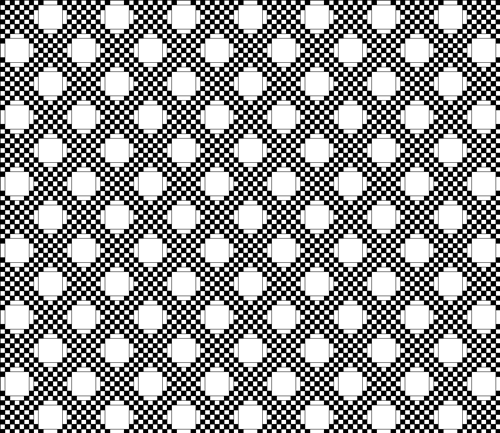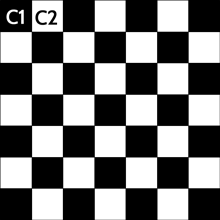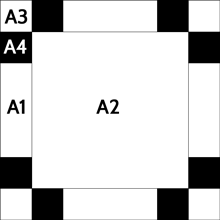Calculating Irish Chain Quilt Fabric Yardage
A Triple Irish Chain Checkerboard Design - Part 1
This post contains affiliate links for which I receive compensation.
How much fabric do you need?
Follow along step-by-step as I help a reader through the calculations.
In its simplest form, it's calculating how much you need for a unique patch in your design multiplied by the number of blocks it's in. Adding a bit extra for insurance. Then repeat for the rest of the patches in the quilt.
It may be a lot of steps, but it's easy once you learn how!
Titianmom wrote asking...
For a Triple Irish Chain quilt, checkerboard pattern, how much of a cream background fabric would I need for a king size quilt?
Before you begin to calculate yardage...
Size does matter. But 'king size' is only the first step in the information gathering process.
You'll also need to know or decide:
- Length and width of mattress top
- How far the quilt should hang down on the sides
- Pillow shams or pillow tuck
To help you decide how big a quilt it takes to cover YOUR bed, I've put together a worksheet that captures all the information you'll need. Click here to download the "Worksheet for Calculating Bed Quilt Sizes".
Next, we consider our design.
In the Triple Irish Chain quilt family, we see that odd numbers of blocks in both the rows and columns are needed to create a symmetrical design.
Decide on a technique. For this project, we'll strip piece when we can.
Different techniques take different amounts of fabric, especially for triangles—but we don't need to consider that for our Irish Chain.
The final crucial bit of information is to decide (or declare) the smallest or largest finished-size patch you'll work with.
The Triple Irish Chain quilt pattern has a nice open space that shouts out for some spectacular quilting. Do you have a special design in mind? What's the smallest/largest you're willing to stitch? (Remember, you can always reduce or enlarge quilting designs on the copy machine before tracing it out.)
Lastly, write everything down and label it!
Even with the best laid plans, things happen. We think we'll get to something right away, but we're interrupted. That's the story of my life.
I've seen nurses carry around a piece of paper in their pocket and call it their brain. Well what's good enough for nurses is good enough for this quilter! Write things down!
Assumptions for our Irish Chain calculations
For Titianmom, I'm calculating yardage for a king size quilt:
- At least 104" x 93" (fits a 78"x80" bed with a 13" drop on three sides, no pillow tuck)
- Grid size is a 1" finished square (that is the smallest patch I'll work with)
- Strip pieced when possible
- Usable width of fabric after the selvedge is removed is 40"
- No shrinkage from batting or quilting (in reality there would be some, but I have no idea what products and quilting Titianmom will use or do)
Step 1: Calculate how many blocks to make
For a symmetrical Triple Irish Chain quilt design, we need odd numbers of blocks in both the rows and columns.
With a grid size of 1" finished, our 7x7 block finishes at 7".
For a quilt top measuring 104" wide by 93" long and a 7"block, then:
Width:
104" ÷ 7" = 14.857 round up** to 15
Length:
93" ÷ 7" = 13.286 round down** to 13
Actual sizes:
(15 blocks x 7") x (13 blocks x 7") = 105" x 91"
**Rounded to the nearest odd number to create a symmetrical Irish Chain design.
NOTE: This is pretty close to the size we were after (104"x93").
Certainly close enough for this example. However, in making this quilt
for your own bed, you may want to add borders, use wider bindings, add
partial blocks or change the grid size to get an exact fit.
Our 15 x 13 block quilt looks like this:
 15x13 blocks
15x13 blocks...with 98 checkerboard blocks and 97 alternates. Whew! That's a lotta blocks! (Click here to see what happens to that number if we use Jelly Roll strips. This link opens in a new window.)
Step 2: Determine 'Cut Width of Strip'
These are the two blocks that comprise the Checkerboard Irish Chain quilt pattern: Checkerboard (left), Alternate (right).
Both are drawn on a 7x7 grid.
 Checkerboard design
Checkerboard design7x7
 Alternate design
Alternate design7x7
For simplicity's sake, we'll run through the calculations for just one patch (#A1) out of the two blocks. (Click here to go to a chart that includes calculations for all the unique patches. This link opens in a separate window so you can refer to it as you follow along here.)
Use the drawings above to find the dimension of each unique patch in 'grid units'.
A1 (the side rectangle on the alternate block) is 1 unit wide by 3 tall.
I'm using a Grid Size of 1".
Convert this to cutting dimensions...
(Grid size x 1) by (Grid size x 3)
(1" x 1) by (1" x 3) = 1" x 3"
You must add 1/2" for seam allowances which results in a patch cut 1-1/2"x3-1/2".
All
the other patches in this block are squares so it's easy to choose the Cut Width.
For A1, most would choose to cut it
from 1-1/2" wide strips. I prefer to cut 3-1/2" wide strips
because I'll be sewing that side 388 times. Lengthwise
grain has virtually no stretch and makes for a truer seam.
All 'Cut Width of Strip' measurements are in the chart in the first row highlighted in yellow.
Step 3: Calculate how many strips to cut for each patch
Refering to the picture of the alternate Irish Chain block, Patch A1 appears 4 times/block. Multiply this times the number of alternate blocks, or...
4 x 97 = 388
We need to know how many of these can be cut from one strip. Divide the 'Usable Width of Fabric' by the 'Sub Cut Measurement'.
Sub Cut Measurement is equal to the other dimension of the patch that we didn't use for the Cut Width of Strip. (Our A1 patch is 1-1/2"x3-1/2". We cut the strip 3-1/2" wide, so the Sub Cut Measurement is 1-1/2".)
40" ÷ 1-1/2" = 26.67 or 26 patches per strip*
*We round down because quilts are made with whole patches.
Divide the number of patches (Total # in Quilt) by the number of patches/strip, or...
388 ÷ 26 = 14.92, or 15 strips*
*We cut whole strips not partials.
The '# of Strips to Cut' is the second row highlighted in yellow.
Step 4: Calculate ' Sub-total Inches Needed'
Things get easier. Just multiply the '# of Strips to Cut' by the 'Cut Width of Strip', or...
15 x 3.5" = 52.5"
To convert to yards, divide by 36...
52.5" ÷ 36" = 1.46 yards
Up until this point, everything has been specific and countable.
However, now we need to add a...
Step 5: Fudge Factor (FF) estimate
This is our insurance to compensate for:
- 'Re-straightening' or 're-squaring' the edge while rotary cutting
- Miscuts
- Shrinkage from prewashing
It's
a personal number. The extra you deem necessary may well be different
than mine. I'll walk you through my estimates, but please revise them as
you see fit.
I plan to re-square my edge about every 8 cuts using up a 1/4" each time. From the '# of Strips to Cut' row, for A1, there are 15 strips. Divide by 8 and multiply by 1/4", or...
15 ÷ 8 = 1-7/8, round to 2 to make the math easy
2 x 1/4" = 1/2" FF for re-straightening cuts
I always prewash.
This Checkerboard Triple Irish Chain quilt has a whole lot o'piecing going on. Bleeding fabric is not an option after the quilt is finished—especially when it's got as much work in it as this. But the choice is up to you.
I estimate losing about 5% or 2" per yard due to shrinkage. For our A1,
52.5" x .05 = 2.625" = 2-5/8" FF for prewashing shrinkage
To the 'Sub-total Inches Needed' of 52.5", I'll add 1/2" for squaring up plus 2-5/8" for shrinkage plus 3-1/2" for the 'Cut Width of Strip' because I'll probably screw up at least one cut, or...
52.5" + .5" + 2.625" + 3.5" = 59.13 Total Inches Needed
These calculations are in the third highlighted yellow row in our chart.
Step 6: Convert to yards and YOU'RE DONE!!!
Divide 'Total Inches Needed' by 36", or...
59.13" ÷ 36" = 1.64
Round up to the nearest 1/4 yard to 1.75 or 1-3/4 Total Yards for A1
These totals are in the very last row.
So to answer Titianmom's question about how much background fabric she'd need, simply add the totals for each background patch, or...
4.25 + 1.75 + 2.5 + .75 = 9.25 yds
Some thoughts about the calculations...
The generosity of your Fudge Factor is totally up to you.
To save a bit of fabric, you could choose instead to add C2, A1, A2 and A3 and then round up to the nearest quarter yard, or...
4.11 + 1.64 + 2.41 + .71 = 8.87 yards,
Roundup to 9 yds background fabric
Those choices are up to you.
The whole purpose of these calculations is to make sure there's ENOUGH fabric so that you don't run out during the quilt's construction.
NEVER, NEVER, EVER be tempted to purchase the exact amount without a Fudge Factor added—if for no other reason than you'll be screwed if you make one mis-cut.
That's just asking for headaches later on.
For more on Irish Chain quilt patterns visit:
- Setting Triangles for an On-Point Quilt Setting, includes a free printable download with all the calculations done for you.
What about a different quilt block?
For a list of all the 220+ quilt block patterns on this site, start here.
If you know the name of the block, shorten your search by using these links:
Click here if you're looking for blocks with at least some paper piecing.
Click here if you're looking for the basic building blocks of quilting, i.e., Flying Geese, half square triangles, quarter square triangles, etc., along with several techniques to make each.
And finally, use these links to find blocks in these finished sizes:










